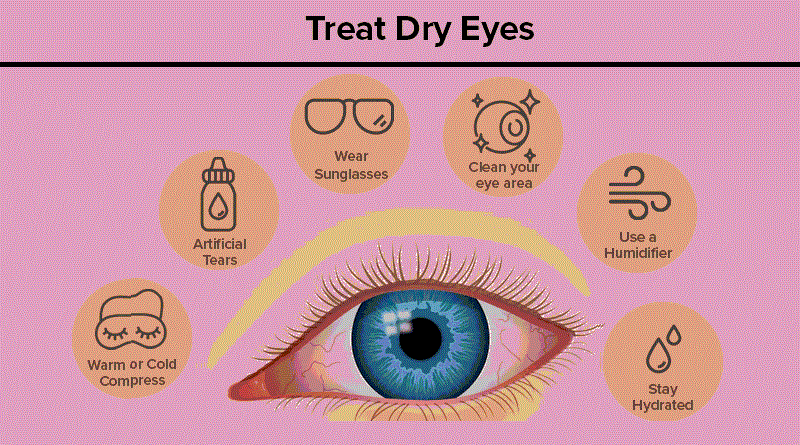Dry Eyes: Understanding the Causes and Management
Have you ever experienced that uncomfortable sensation of dry eyes? If so, you may be familiar with that common condition. While it may seem like a minor inconvenience, dry eye can significantly impact your quality of life. In this article, we will discuss dry eyes, exploring its causes, symptoms, and available remedies to help you find relief.
Defining Dry Eye
Dry eye, also referred to as dry eye syndrome or keratoconjunctivitis sicca, is a multifactorial condition characterized by an insufficient quantity or quality of tears to lubricate and nourish the eyes. Tears are essential for maintaining the health and clarity of the front surface of the eye and providing smooth and clear vision. When the tear film is disrupted, it can lead to various uncomfortable symptoms and potential damage to the ocular surface.
Understanding the Tears
To understand dry eye, it is important to grasp the composition and function of tears. Contrary to popular belief, tears are not just a response to emotions like sadness or joy. They are composed of three layers:
- The outer oily (lipid) layer:
This layer, produced by the meibomian glands located in the eyelids, helps prevent evaporation of tears and ensures a smooth tear film distribution. - The middle watery (aqueous) layer:
The main component of tears, produced by the lacrimal glands, this layer provides moisture, oxygen, and nutrients to the cornea and conjunctiva. - The inner mucous layer:
The goblet cells within the conjunctiva secrete this layer, which helps the tear film spread evenly over the eye’s surface.
Causes and Risk Factors
Dry eye can stem from various factors, including:
- Aging:
As we get older, tear production tends to decrease, leading to a higher risk of dry eye. - Environmental factors:
Dry or windy climates, exposure to air conditioning or heating, and prolonged screen time can contribute to dry eye symptoms. - Medical conditions:
Certain health conditions like Sjögren’s syndrome, rheumatoid arthritis, diabetes, and thyroid disorders can increase the likelihood of dry eye. - Medications:
Antihistamines, decongestants, antidepressants, and medications that lower blood pressure are among the drugs that may cause or exacerbate dry eye symptoms. - Hormonal changes:
Fluctuations in hormone levels due to pregnancy, menopause, or oral contraceptive use can influence tear production. - Contact lens wear:
Improper lens care or wearing contact lenses for extended periods can lead to dry eye symptoms.
Symptoms
Dry eye can manifest through a variety of symptoms, including:
- Dryness: A persistent sensation of dryness or itchiness in the eyes.
- Redness: Bloodshot or irritated eyes may occur due to the lack of moisture.
- Blurred vision: Dry eye can temporarily blur your vision, especially during activities that require visual concentration.
- Sensitivity to light: Increased sensitivity to light, known as photophobia, can be a sign of dry eye.
- Eye fatigue: Frequent eye strain, discomfort, or a feeling of heaviness after reading or using digital devices may indicate dry eye.
Treatment and Management
Fortunately, several treatments and management strategies can provide relief for dry eye sufferers. These include:
- Artificial tears:
Over-the-counter lubricating eye drops can help alleviate dryness and provide temporary relief. - Prescription medications:
Your eye doctor may prescribe medicated eye drops or ointments to reduce inflammation and promote tear production. - Lifestyle adjustments:
Taking regular breaks during prolonged screen use, using a humidifier in dry environments, and avoiding smoky or dusty areas can help manage symptoms. - Warm compresses and eyelid hygiene:
Applying a warm compress to the eyelids and gently cleaning the eyelid margins can help unclog blocked meibomian glands and improve tear quality. - Dietary supplements:
Omega-3 fatty acids, commonly found in fish oil, may help reduce inflammation and improve dry eye symptoms.
When to Seek Medical Help
While mild cases of dry eye can often be managed with self-care measures, but you have to consult an eye care professional if:
- Your symptoms persist or worsen despite using artificial tears or other over-the-counter remedies.
- You experience severe pain, redness, or sudden changes in vision.
- Dry eye symptoms significantly affect your daily activities or quality of life.
Conclusion
Dry eye is a common condition that can cause discomfort, affect vision, and impact your overall well-being. By understanding its causes, recognizing the symptoms, and exploring available remedies, you can take proactive steps to manage dry eye and find relief. Remember, if your symptoms persist or worsen, seeking professional help is essential to ensure the best possible care for your eyes. Stay vigilant, prioritize eye health, and enjoy a life free from the discomfort of dry eyes.
If you suspect that you may have symptoms, Helalmedical can help, offering quick, private, and convenient testing options. You may contact us here: Facebook page.




